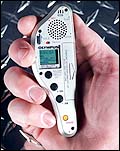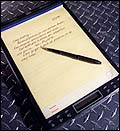And we'll have fun, fun, fun,
'til the boss takes the CrossPad away
By David Armstrong, Globe Staff, 07/29/99
 The Olympus V-90: Even your voice is digitized with this amazingly small, feature-packed recorder.
The Olympus V-90: Even your voice is digitized with this amazingly small, feature-packed recorder.
 The Cross Pad: Sometimes taking notes with paper and pen is unavoidable. But you can do it digitally.
The Cross Pad: Sometimes taking notes with paper and pen is unavoidable. But you can do it digitally.
 The Polaroid Finger Scanner: Forget passwords forever, and protect your PC at the same time.
The Polaroid Finger Scanner: Forget passwords forever, and protect your PC at the same time.
(Globe Staff Photos / Pam Berry)
|
Drat all these changes.
You just got a fancy new cell phone, but can't figure out how to have it automatically dial your voice mailbox at work.
The sync cradle for your Palm Pilot won't download your calendar from Lotus Notes.
And Windows won't shut down from the Start menu.
Hey, wasn't technology supposed to make life easier?
There are lots of techno devices already here or coming down the pike that not only make your work life go more smoothly, but are fun to use, too. Here's a look at three we found.
Everyone hates passwords and for good reason. There's a password for your ATM, a password to get into the company parking lot, a password to get into the building, a password to log onto your PC, a password to check your voice mail.
Inevitably, we forget one password or another at some point.
Polaroid (www.polaroid.com) is one of several companies offering products that promise to make memorizing computer passwords a thing of the past, while also offering improved security for your office or home PC.
The Finger Imaging Scanner PFS-100 capitalizes on the science of biometrics, the study of measuring unique biological traits and characteristics. A fingerprint is one of those traits.
Engineers have spent considerable time developing a fingerprint scanner with a minimum of parts.
Polaroid and other companies are negotiating with keyboard makers to install the scanner along the top of standard boards. Polaroid officials say the unit adds less than $50 to the cost of a keyboard. It expects keyboards with built-in scanners to appear on the market later this year.
How it works: The software to operate the scanner is called Midas. You establish a password account with Midas and scan a fingerprint image to be used as your password.
The next time you log on, a box appears on your PC screen prompting you to supply a fingerprint image. When you place your finger in the slot, an image of your fingerprint appears on the screen above a bar measuring the quality of the scan.
If the print is recognized, the box disappears and the start-up screen appears. If the print is rejected, and several attempts to fool the scanner fail, a message appears saying the fingerprint is not registered.
I experienced a problem after establishing my left index finger as the password key. The scanner had a hard time recognizing the image in subsequent scans. Polaroid says about 5 percent of fingers are difficult to scan. When I established an account with my right index finger, I had no trouble.
Logging on with the scanner was painless, and after repeated use, I longed to have this gizmo on my PC. Unfortunately, the scanner I used was a demo.
The Midas software goes beyond simply protecting your PC; it allows you to lock specific files and applications as well. It also permits multiple users on the same machine, a particularly useful feature in workplaces where people on different shifts share the same PC.
In the future, biometric proponents envision scanners as a key component of e-commerce security. Consider the following scenario: You log on to a Web store and place your order for a book. Next to your finger scanner is a built-in magnetic card swipe that runs along the top of your keyboard. You are prompted to run your credit card through the card swipe. Then, to ensure against fraud, you are asked to provide your fingerprint.
The finger image scanner has obvious Orwellian implications that are sure to worry privacy proponents. It's one thing to give a company your credit card number; it's a whole other ballgame when they have a record of a unique part of you.
The image taken and stored by the Polaroid scanner is not of a fingerprint, but of fingerprint minutia. Minutia are the unique characteristics of a fingerprint. Polaroid links the characteristics using an algorithm to create a pattern for each user. Even though the image stored is not of the actual fingerprint, the image itself is unique.
Polaroid acknowledges the potential concern of privacy advocates, but views the advent of its product as a balancing act. ``Some intrusiveness is traded to achieve security,'' according to the company.
Although computers may portend a paperless world, there are still times when taking notes on pulp products is either unavoidable or preferable.
A judge, for instance, is unlikely to tolerate a lawyer who taps away on a laptop while listening to a witness testify. Writing on paper remains a quiet exercise.
The A.T. Cross Co. (www.cross.com) in Lincoln, R.I., came up with a way to take advantage of the best of the old and new with its CrossPad portable digital notepad.
This product enables you to upload your handwritten notes to your PC or laptop and, with some training and effort, translate your notes into computerized form.
Cross offers two versions of this product. The CrossPad ($299) is designed to take notes using letter-size (8.5- by 11-inch) notepads. A newer product, the CrossPad XP ($249), is a smaller version that uses memo-size (6- by 9-inch) notebooks.
The key to the CrossPad is a special pen with a transmitter that sends digital signals to the tablet underneath the paper pad while producing traditional ink for your note taking.
The tablet itself is lightweight and not much bigger than the paper notebook. A digital display at the bottom of the tablet indicates which page is being recorded and menu options. A tap of the digital pen allows the user to move between pages.
After taking notes on the digital tablet, the CrossPad can be connected to a PC through any COM port. A simple menu command triggers an uplink of the digital notes to the PC.
The notes can be stored as images - a picture of the page with your notes scribbled on it - or the IBM Ink Manager software packaged with the CrossPad can translate your notes into electronic text.
This latter process, however, is tricky. When the Ink Manager software first tried to translate my admittedly difficult-to-read handwriting to text, the results were poor. Most of the words were misinterpreted.
The software includes a program to help recognize your unique writing characteristics. The improved handwriting recognition exercises, however, are time-consuming and do not guarantee 100 percent accuracy.
If you don't need to convert your notes into electronic text, the software allows you to establish keywords and bookmarks in your notes for quick retrieval of the page image.
Tape recorders have been a tool in workplaces for decades. But how about a tape recorder that doesn't need any tape?
The V-90 Digital Voice Recorder ($99) by Olympus (www.olympus.com) is one of a new wave of recording devices that store recordings electronically.
This device is stunning for both its size and ease of use.
The ergonomically-designed recorder easily fits into the palm of your hand. The most important buttons, such as play and record, are located where the thumb and index finger rest.
The device is so light that even the accompanying instruction booklet outweighs it.
Despite its size, this recorder comes with many bells and whistles.
Messages are recorded and stored in three folders. Each folder can store up to 99 messages or recordings, but the overall combined maximum recording time is 90 minutes.
An LCD (liquid crystal display) window indicates date, time, battery life, recording length, and the numbered message being recorded or played. The recording quality is surprisingly good.
One impressive feature is an alarm. It allows you to select a message you want played and the date and time you want to hear it. At the appropriate time, a series of beeps sounds. Press any button, and the preselected message plays.
David Armstrong does computer-assisted reporting for the Globe. His e-mail address is [email protected].


